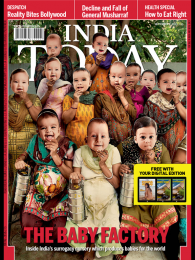Making babies to order, selling ‘extras’ on the black market…

Outsourcing pregnancy, baby factories, wombs-for-rent, baby farms, and breeders are some of the terms used in discussing the international market for surrogacy—none of which are very flattering. But HBO Watch editor Jef Dinsmore goes a step farther in describing the booming surrogacy business in India: “Running a ‘baby farm’ is a seedy, nasty business.”
In his blurb for the HBO Vice documentary “Outsourcing Embryos,” Dinsmore describes a scene where correspondent Gianna Toboni watched “a typical hurried procedure.”
It would take too long to have a woman go through full dilation, timed contractions and Lamaze-trained breathing and pushing, so instead a C- section is the only way to go. After the baby is delivered, checked and cleaned, it was whisked downstairs where the intended mother waited. She and her bundle of joy were united and taken away via a van waiting for them. By the time Gianna gets back upstairs another pregnant woman is on the table. The whole rapid moment even had our correspondent a bit rattled.
Dinsmore concludes that “it is a business venture and nothing more.”
A surrogate recruiter … goes out in search for potential women. … Business is booming and the demand for infants rises higher, so a quick inventory of child-bearing women must keep up the supply. … It exploits the poor caste women of the region.
Jessica Cussins wrote a review of the HBO documentary for The Center for Genetics and Society. In “It’s a Baby Farm,” she says it was “eye-opening, even for those who have been following the surge of cross-border ‘womb-renting’ for years.”
India’s medical tourism industry is now worth $2.3 billion, with $500 million of that solely from the legalization of commercial surrogacy. Couples travel to India from all over the world to take advantage of prices that are a sixth of the cost in the US – about $30-60,000 from a reputable clinic. But, as Toboni explains, the problem with commercialization is that “businesses start under-cutting one another and next thing you know, we’re bidding for the cheapest baby.”
To find out how low the prices could go, Toboni went undercover and found a man working from a back alley who offered a guaranteed delivery for just $12,000.
At the other end of the spectrum is Dr. Nayna Patel, who is surely the most well-known fertility specialist in India. She is currently building what will be the largest surrogacy clinic in the world, an “all-inclusive facility” that will eliminate the need for a hospital entirely.
Patel schedules all of the women working for her as surrogates to undergo C-sections, so she can perform deliveries back to back. After watching one herself, Toboni was visibly shaken. “We just saw a baby being born ten minutes ago and already we’re racing back upstairs to see the next baby being born. It’s like this turn-over is so quick here.”
According to Patel, surrogates carrying a foreign couple’s baby can make about $9,500 for one, or $12,000 for twins. Patel is adamant that surrogacy is highly beneficial to the woman who take part. And indeed, many women find it to be the best option available to them.
A woman named Vasanti told Toboni, “Nobody likes doing this. I didn’t have a home, so I thought I could build one by being a surrogate.”
Another surrogate, Nisha, told her “It does feel a little bad, but what can I do? I’m helpless. There are no alternatives.”
Toboni found non-profit organizations that purportedly “empower” women to find employment, but effectively work as surrogacy recruiters by explaining to women living in extreme poverty how the payment compares to the alternatives of housecleaning or menial labor. Other recruiters regularly comb through the slums.
Despite Patel’s insistence that she discourages this practice, a recruiter found in the Mahavir slum claimed to be working directly for her, and seemed to be skimming several thousands of dollars off the payments to women that had been quoted by Patel.
Cussins describes other ethical missteps in baby factory business.
The documentary includes Michele Goodwin, Chancellor’s Professor of Law at UC Irvine, explaining that clinics are motivated to implant multiple embryos at a time to maximize their chances of delivering a “successful product.” As well as putting the surrogate mother and babies at additional health risks, this ends up leading to “extra” babies that the commissioning parents weren’t expecting. As the Baby Gammy controversy of last summer made clear, some unwanted babies simply get abandoned.
And there is an even darker side to this already “seedy business.”
While posing as potential clients over dinner with a surrogacy broker, two Vice correspondents are shown a baby and told, “you can take that baby now… Let’s just make the deal now.” Toboni explains their reaction,
We soon realized that this woman was actually trying to sell us the baby they had brought with them to the restaurant. This wasn’t renting someone’s womb. This was human trafficking.
This fifteen-minute documentary shows the complex reality of the unregulated world of commercial surrogacy, beyond the smiling photos of beautiful babies and appealing price tags. As Goodwin puts it: “It’s a baby farm.”
HBO Watch editor Jef Dinsmore’s blurb for “Outsourcing Embryos” can be found here.
Jessica Cussins’ review, “It’s a Baby Farm,” is available at the The Center for Genetics and Society website.
In an interview with New York Magazine, “Inside the Dark Realities of the International Surrogacy Industry,” Gianna Toboni spoke directly to the black market for “extra” babies.
A clip of the documentary, “Breeders,” produced by the Center for Bioethics and Culture is available here. It can be rented or purchased and would be excellent for use in a Sunday school class on ethics or bioethics.


 October 15, 2015
October 15, 2015 







Comments are closed.